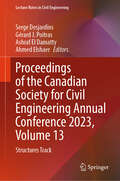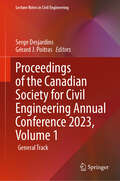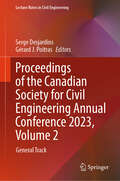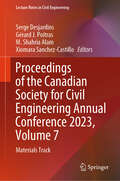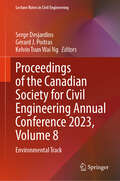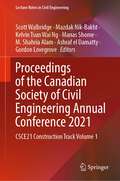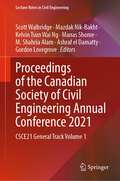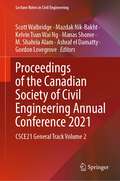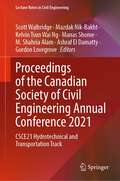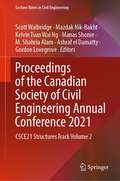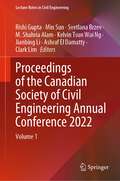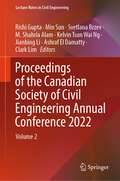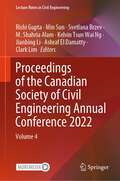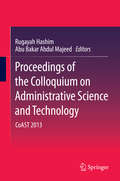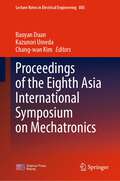- Table View
- List View
Proceedings of the Canadian Society for Civil Engineering Annual Conference 2023, Volume 13: Structures Track (Lecture Notes in Civil Engineering #507)
by Ashraf El Damatty Serge Desjardins Gérard J. Poitras Ahmed ElshaerThis book comprises the proceedings of the Annual Conference of the Canadian Society for Civil Engineering 2023. The contents of this volume focus on the specialty track in structural engineering with topics on bridge design, FRP concrete structures, innovation in structural engineering, seismic analysis and design, wind load on structures, masonry structures, structural optimization, machine learning and AI in structural engineering, and wood and timber structures, among others. This volume will prove a valuable resource for researchers and professionals.
Proceedings of the Canadian Society for Civil Engineering Annual Conference 2023, Volume 1: General Track (Lecture Notes in Civil Engineering #495)
by Serge Desjardins Gérard J. PoitrasThis book comprises the proceedings of the Annual Conference of the Canadian Society for Civil Engineering 2023. The contents of this volume focus on the general conference with topics on transportation, climate adaptability, sustainable design, green buildings, cold regions, and civil engineering education, among others. This volume will prove a valuable resource for researchers and professionals.
Proceedings of the Canadian Society for Civil Engineering Annual Conference 2023, Volume 2: General Track (Lecture Notes in Civil Engineering #496)
by Serge Desjardins Gérard J. PoitrasThis book comprises the proceedings of the Annual Conference of the Canadian Society for Civil Engineering 2023. The contents of this volume focus on the general conference with topics on transportation, climate adaptability, sustainable design, green buildings, cold regions, and civil engineering education, among others. This volume will prove a valuable resource for researchers and professionals.
Proceedings of the Canadian Society for Civil Engineering Annual Conference 2023, Volume 3: Construction Track (Lecture Notes in Civil Engineering #497)
by Mazdak Nik-Bakht Serge Desjardins Gérard J. PoitrasThis book comprises the proceedings of the Annual Conference of the Canadian Society for Civil Engineering 2023. The contents of this volume focus on the specialty track in construction with topics on modular and offsite construction, BIM, construction planning and project management, construction automation, AI and robotics in construction, sustainable construction, asset management, and construction safety, among others. This volume will prove a valuable resource for researchers and professionals.
Proceedings of the Canadian Society for Civil Engineering Annual Conference 2023, Volume 4: Construction Track (Lecture Notes in Civil Engineering #498)
by Mazdak Nik-Bakht Serge Desjardins Gérard J. PoitrasThis book comprises the proceedings of the Annual Conference of the Canadian Society for Civil Engineering 2023. The contents of this volume focus on the specialty track in construction with topics on modular and offsite construction, BIM, construction planning and project management, construction automation, AI and robotics in construction, sustainable construction, asset management, and construction safety, among others. This volume will prove a valuable resource for researchers and professionals.
Proceedings of the Canadian Society for Civil Engineering Annual Conference 2023, Volume 5: Construction Track (Lecture Notes in Civil Engineering #499)
by Mazdak Nik-Bakht Serge Desjardins Gérard J. PoitrasThis book comprises the proceedings of the Annual Conference of the Canadian Society for Civil Engineering 2023. The contents of this volume focus on the specialty track in construction with topics on modular and offsite construction, BIM, construction planning and project management, construction automation, AI and robotics in construction, sustainable construction, asset management, and construction safety, among others. This volume will prove a valuable resource for researchers and professionals.
Proceedings of the Canadian Society for Civil Engineering Annual Conference 2023, Volume 6: Materials Track (Lecture Notes in Civil Engineering #500)
by M. Shahria Alam Serge Desjardins Gérard J. Poitras Xiomara Sanchez-CastilloThis book comprises the proceedings of the Annual Conference of the Canadian Society for Civil Engineering 2023. The contents of this volume focus on the specialty track in materials with topics on recycled materials, concrete durability, geopolymers, alkali-activated and other alternative binders, fiber-reinforced and engineered cementitious composites, advanced composite materials, ultra-high-performance materials, and innovative and emerging materials, among others. This volume will prove a valuable resource for researchers and professionals.
Proceedings of the Canadian Society for Civil Engineering Annual Conference 2023, Volume 7: Materials Track (Lecture Notes in Civil Engineering #501)
by M. Shahria Alam Serge Desjardins Gérard J. Poitras Xiomara Sanchez-CastilloThis book comprises the proceedings of the Annual Conference of the Canadian Society for Civil Engineering 2023. The contents of this volume focus on the specialty track in materials with topics on recycled materials, concrete durability, geopolymers, alkali-activated and other alternative binders, fiber-reinforced and engineered cementitious composites, advanced composite materials, ultra-high-performance materials, and innovative and emerging materials, among others. This volume will prove a valuable resource for researchers and professionals.
Proceedings of the Canadian Society for Civil Engineering Annual Conference 2023, Volume 8: Environmental Track (Lecture Notes in Civil Engineering #502)
by Kelvin Tsun Wai Ng Serge Desjardins Gérard J. PoitrasThis book comprises the proceedings of the Annual Conference of the Canadian Society for Civil Engineering 2023. The contents of this volume focus on the specialty track in environmental engineering with topics on water and wastewater treatment, sustainability and climate change, remediation, and environmental hazards, among others. This volume will prove a valuable resource for researchers and professionals.
Proceedings of the Canadian Society for Civil Engineering Annual Conference 2023, Volume 9: Hydrotechnical Track (Lecture Notes in Civil Engineering #503)
by Serge Desjardins Gérard J. Poitras Amir Hossein AzimiThis book comprises the proceedings of the Annual Conference of the Canadian Society for Civil Engineering 2023. The contents of this volume focus on the specialty track in hydrotechnical engineering with topics on hydraulic structures, river engineering, water management, hydrology and machine learning, fluvial hydraulics, and sediment transport, among others. This volume will prove a valuable resource for researchers and professionals.
Proceedings of the Canadian Society of Civil Engineering Annual Conference 2021: CSCE21 Construction Track Volume 1 (Lecture Notes in Civil Engineering #251)
by Scott Walbridge Mazdak Nik-Bakht Kelvin Tsun Wai Ng Manas Shome M. Shahria Alam Ashraf El Damatty Gordon LovegroveThis book comprises the proceedings of the Annual Conference of the Canadian Society of Civil Engineering 2021. The contents of this volume focus on specialty conferences in construction, environmental, hydrotechnical, materials, structures, transportation engineering, etc. This volume will prove a valuable resource for those in academia and industry.
Proceedings of the Canadian Society of Civil Engineering Annual Conference 2021: CSCE21 Construction Track Volume 2 (Lecture Notes in Civil Engineering #247)
by Scott Walbridge Mazdak Nik-Bakht Kelvin Tsun Wai Ng Manas Shome M. Shahria Alam Ashraf El Damatty Gordon LovegroveThis book comprises the proceedings of the Annual Conference of the Canadian Society of Civil Engineering 2021. The contents of this volume focus on specialty conferences in construction, environmental, hydrotechnical, materials, structures, transportation engineering, etc. This volume will prove a valuable resource for those in academia and industry.
Proceedings of the Canadian Society of Civil Engineering Annual Conference 2021: CSCE21 Environmental Track (Lecture Notes in Civil Engineering #249)
by Scott Walbridge Mazdak Nik-Bakht Kelvin Tsun Wai Ng Manas Shome M. Shahria Alam Ashraf El Damatty Gordon LovegroveThis book comprises the proceedings of the Annual Conference of the Canadian Society of Civil Engineering 2021. The contents of this volume focus on specialty conferences in construction, environmental, hydrotechnical, materials, structures, transportation engineering, etc. This volume will prove a valuable resource for those in academia and industry.
Proceedings of the Canadian Society of Civil Engineering Annual Conference 2021: CSCE21 General Track Volume 1 (Lecture Notes in Civil Engineering #239)
by Scott Walbridge Mazdak Nik-Bakht Kelvin Tsun Wai Ng Manas Shome M. Shahria Alam Ashraf El Damatty Gordon LovegroveThis book comprises the proceedings of the Annual Conference of the Canadian Society of Civil Engineering 2021. The contents of this volume focus on specialty conferences in construction, environmental, hydrotechnical, materials, structures, transportation engineering, etc. This volume will prove a valuable resource for those in academia and industry.
Proceedings of the Canadian Society of Civil Engineering Annual Conference 2021: CSCE21 General Track Volume 2 (Lecture Notes in Civil Engineering #240)
by Scott Walbridge Mazdak Nik-Bakht Kelvin Tsun Wai Ng Manas Shome M. Shahria Alam Ashraf El Damatty Gordon LovegroveThis book comprises the proceedings of the Annual Conference of the Canadian Society of Civil Engineering 2021. The contents of this volume focus on specialty conferences in construction, environmental, hydrotechnical, materials, structures, transportation engineering, etc. This volume will prove a valuable resource for those in academia and industry.
Proceedings of the Canadian Society of Civil Engineering Annual Conference 2021: CSCE21 Hydrotechnical and Transportation Track (Lecture Notes in Civil Engineering #250)
by Scott Walbridge Mazdak Nik-Bakht Kelvin Tsun Wai Ng Manas Shome M. Shahria Alam Ashraf El Damatty Gordon LovegroveThis book comprises the proceedings of the Annual Conference of the Canadian Society of Civil Engineering 2021. The contents of this volume focus on specialty conferences in construction, environmental, hydrotechnical, materials, structures, transportation engineering, etc. This volume will prove a valuable resource for those in academia and industry.
Proceedings of the Canadian Society of Civil Engineering Annual Conference 2021: CSCE21 Materials Track (Lecture Notes in Civil Engineering #248)
by Scott Walbridge Mazdak Nik-Bakht Kelvin Tsun Wai Ng Manas Shome M. Shahria Alam Ashraf El Damatty Gordon LovegroveThis book comprises the proceedings of the Annual Conference of the Canadian Society of Civil Engineering 2021. The contents of this volume focus on specialty conferences in construction, environmental, hydrotechnical, materials, structures, transportation engineering, etc. This volume will prove a valuable resource for those in academia and industry.
Proceedings of the Canadian Society of Civil Engineering Annual Conference 2021: CSCE21 Structures Track Volume 2 (Lecture Notes in Civil Engineering #244)
by Scott Walbridge Mazdak Nik-Bakht Kelvin Tsun Wai Ng Manas Shome M. Shahria Alam Ashraf El Damatty Gordon LovegroveThis book comprises the proceedings of the Annual Conference of the Canadian Society of Civil Engineering 2021. The contents of this volume focus on specialty conferences in construction, environmental, hydrotechnical, materials, structures, transportation engineering, etc. This volume will prove a valuable resource for those in academia and industry.
Proceedings of the Canadian Society of Civil Engineering Annual Conference 2022: Volume 1 (Lecture Notes in Civil Engineering #363)
by Rishi Gupta Kelvin Tsun Wai Ng M. Shahria Alam Ashraf El Damatty Min Sun Svetlana Brzev Jianbing Li Clark LimThis book comprises the proceedings of the Annual Conference of the Canadian Society of Civil Engineering 2022. The contents of this volume focus on specialty conferences in construction, environmental, hydrotechnical, materials, structures, transportation engineering, etc. This volume will prove a valuable resource for those in academia and industry.
Proceedings of the Canadian Society of Civil Engineering Annual Conference 2022: Volume 2 (Lecture Notes in Civil Engineering #348)
by Rishi Gupta Kelvin Tsun Wai Ng M. Shahria Alam Ashraf El Damatty Min Sun Svetlana Brzev Jianbing Li Clark LimThis book comprises the proceedings of the Annual Conference of the Canadian Society of Civil Engineering 2022. The contents of this volume focus on specialty conferences in construction, environmental, hydrotechnical, materials, structures, transportation engineering, etc. This volume will prove a valuable resource for those in academia and industry.
Proceedings of the Canadian Society of Civil Engineering Annual Conference 2022: Volume 3 (Lecture Notes in Civil Engineering #359)
by Rishi Gupta Kelvin Tsun Wai Ng M. Shahria Alam Ashraf El Damatty Min Sun Svetlana Brzev Jianbing Li Clark LimThis book comprises the proceedings of the Annual Conference of the Canadian Society of Civil Engineering 2022. The contents of this volume focus on specialty conferences in construction, environmental, hydrotechnical, materials, structures, transportation engineering, etc. This volume will prove a valuable resource for those in academia and industry.
Proceedings of the Canadian Society of Civil Engineering Annual Conference 2022: Volume 4 (Lecture Notes in Civil Engineering #367)
by Rishi Gupta Kelvin Tsun Wai Ng M. Shahria Alam Ashraf El Damatty Min Sun Svetlana Brzev Jianbing Li Clark LimThis book comprises the proceedings of the Annual Conference of the Canadian Society of Civil Engineering 2022. The contents of this volume focus on specialty conferences in construction, environmental, hydrotechnical, materials, structures, transportation engineering, etc. This volume will prove a valuable resource for those in academia and industry.
Proceedings of the Colloquium on Administrative Science and Technology
by Rugayah Hashim Abu Bakar Abdul MajeedThis book of proceedings collects fifty-one papers presented at the inaugural Colloquium of Administrative Science and Technology (CoAST 2013) event, held at Kuching, Sarawak, Malaysia. It has been reviewed by 750 experts world-wide and covers three main areas - Administrative Science and Technology, Management, and Arts and Humanities. The papers in this volume reflect: * the importance of the social sciences in academia and in the nations' social-economic growth; * the multi-disciplinary and trans-disciplinary nature of academia that transcends the broad areas of the social sciences; * the increasing trend towards fundamental studies in the social sciences, management, and the arts and the humanities, which have been characterized under the overarching theme of administrative science and technology; * the growing demand for research outcomes affecting the public and private sectors' service processes. The other overlapping niche areas affecting the civil service scope will ensure more interest in and readability of the findings showcased in this proceedings book; * the popular and contemporary measurement techniques and methodologies employed within the scopes of the social sciences and humanities; * the noticeably changing trends in administrative science and technology, which will greatly impact the governments of the world, allowing the development of a better understanding of governmental processes and their impact on key performance and e-service deliveries. The reporting on technology-based services will improve the public sector's agility; * a knowledge-sharing agenda for other developing and less developed nations to emulate; * some of the major generic developments that have taken place in these thematic areas of CoAST 2013.
Proceedings of the Conference BioSangam 2022: Emerging Trends in Biotechnology (Advances in Biological Sciences Research #24)
by Joyabrata Mal Vishnu Agarwal Rupika SinhaThis is an open access book.It gives us immense pleasure to invite you to join international conference 5th BioSangam, “BioSangam 2022: Emerging trends in Biotechnology”, to be held at one of the most ancient and culturally rich city of India “Kumbh Nagari”, Prayagraj from March 10-12, 2022. Unfortunately, due to ongoing COVID-19 situation, this BioSangam 2022 will be held in online mode. The conference is being organized by Department of Biotechnology, Motilal Nehru National Institute of Technology (MNNIT) Allahabad, Prayagraj UP India with an aim to promote excellence in scientific knowledge and innovation in biotechnology and related disciplines to motivate young researchers. The conference also envisages providing a forum to researchers around the globe to explore and discuss on various aspects on recent advances in the field of agriculture, environment and health that has dynamically opened up new avenues of research. It will provide deep insights into innovations, challenges and growth opportunities in diversified domains of Biotechnology. The conference consists of various sessions including keynotes, plenary talks and parallel sessions. Each session will be addressed by outstanding experts who will highlight recent advances in various facets of biotechnology. It will also offer budding scientist an opportunity to present their work in front of eminent experts of their field and compete for various awards like BioSangam Young Scientist Awards-2022.
Proceedings of the Eighth Asia International Symposium on Mechatronics (Lecture Notes in Electrical Engineering #885)
by Baoyan Duan Kazunori Umeda Chang-Wan KimThe book presents high-quality papers from the Eighth Asia International Symposium on Mechatronics (AISM 2021). It discusses the latest technological trends and advances in electromechanical coupling and environmental adaptability design of electronic equipment, sensing and measurement, mechatronics in manufacturing and automations, energy harvesting & storage, robotics, automation and control systems. It includes papers based on original theoretical, practical and experimental simulations, development, applications, measurements, and testing. The applications and solutions discussed in the book provide excellent reference material for future product development.
